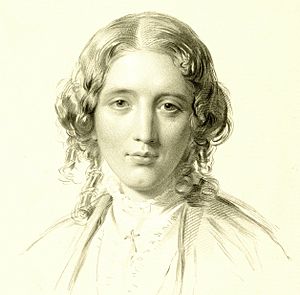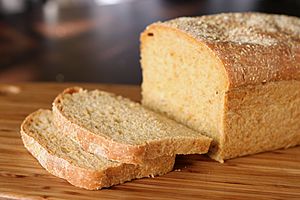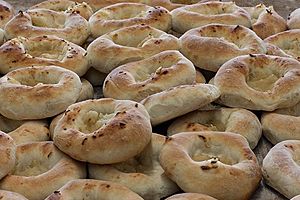Bread in American cuisine facts for kids
Bread in American cuisine includes many types of breads, both leavened (which rise) and flatbreads (which are flat). People in America have been making and eating bread since the time of the Thirteen Colonies, making it a very old and important part of American cuisine.
Contents
History of Bread in America

Long before the American Revolution, families often baked their own bread at home. They used special cast iron ovens. This was different from other places where bread was baked in big shared ovens or bakeries. Making bread at home stayed common until after the American Civil War.
After the Civil War, women's roles in society started to change. People began to worry that breads made in factories would not taste as good or be as high quality as homemade bread. Books for homemakers encouraged women to keep baking bread at home. For example, Catherine Beecher and Harriet Beecher Stowe wrote that women should "return to the good yeast-bread of their sainted grandmothers." They meant that old-fashioned homemade bread was the best.
By the 1920s, making white bread became much easier because of new machines. This was also when pre-sliced bread first became available. Some say it started in Chillicothe, Missouri. Because of these changes, some older types of wheat, like Marquis wheat, were grown less often. White bread became a symbol of new, modern ways of making things in factories.
How Yeast Was Used
Yeast is a tiny living thing that makes bread dough rise. It can make bread taste sweet or a bit sour. But people also made bread without yeast! One way was to mix water and flour into a batter, like pancake batter. They would put this batter in a tin pail in warm water. Over time, wild yeast (natural yeast from the air and flour) would grow and make the batter rise. Once it rose, more flour was added to make a dough. Then it was shaped into loaves and left to dry a little before baking.
Another way to make bread without yeast was by using a mix of cream of tartar (an acid) and sodium bicarbonate (baking soda). Baking soda could also be used to make sour milk less sour for baking soft "sour milk bread."
People could also make their own yeast. They would boil flour with sugar and salt to create a "yeast water." This solution could be put into bottles and used when regular baker's yeast was not available.
Different Kinds of Bread
Anadama Bread
Anadama bread is a yeast bread made with cornmeal and molasses. It comes from the North Shore area of Boston. Several towns in that area say they invented this unique bread.
Bagels
Bagels became a popular street food in New York City's Lower East Side in the early 1900s. This happened when many Jewish immigrants from Eastern Europe arrived. In 1907, the International Beigel Bakers' Union was formed. It had 300 bagel bakers. Bagels were handmade in small bakeries, often in basements. The way to make them was a secret! Only the sons of union members were allowed to learn the recipes. No one else could become an apprentice or be taught how to make them.
Bialy
Bialys are another type of bread linked to Jewish American cooking. Like bagels, they became popular in America in the early 1900s with the arrival of Jewish immigrants from Eastern Europe.
Brown Bread
Brown bread was made using "Indian meal" (which is corn meal) and rye. Sometimes, molasses was added to make it sweeter and darker.
Potato Bread
Historically, potato bread was made with boiled and mashed potatoes. The potatoes were allowed to ferment (a process where tiny organisms change the food). One expert, Esther Allen Howland, suggested using water instead of milk. She said that bread made with milk spoiled faster. Howland also noted that "The more potatoes you use, the lighter the bread will be." But she warned that too many potatoes would make the bread so light that it would dry out quickly.



